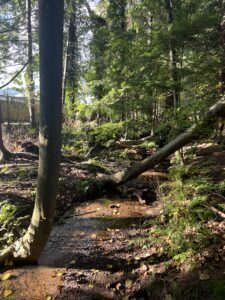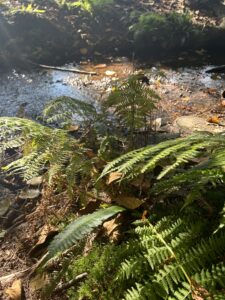Date: 17-09-2024
Time: 16:02
Location: Pierard Creek, North Vancouver, BC, 49.337029, -123.029941
Weather: 20℃, clear and sunny
Season: early fall
I have chosen a lightly wooded trail area with a small creek running beside it for my field research project. The area is roughly 300 ft long and 75 ft wide. Its landscape consists of a small gently rolling area with minimal elevation changes, creating quite uniform topography. The trail is quite small, and situated in a residential area.
I visited the area at about 16:00, on a clear and sunny day in the early fall. It was 20℃, and sun was streaming in through the trees, mostly hitting the east side of the creek at this time. Because of the season, the forest floor was covered in brown leaves and pine needles that dropped from the tree canopy covering the area.
It has lightly wooded patches scattered throughout, except for the actively-used trail, which has been clearcut. Much of the wooded areas consist of large jagged tree stumps which act as nursery stumps (have smaller trees sprouting out of them). The vegetation, in general, is quite sparse, with most of it being large trees. Along the narrow creek which is running through the area, there are more layers of vegetation, such as ferns and shrubs. This creates a slightly denser vegetation area lining the creek. The creek sits slightly below the rest of the forest floor, at the base of two small banks.
While observing this ecosystem, a few interesting questions arose for me, which could be further explored in my field research project:
- Does the sun exposure close to the creek explain the higher density vegetation in this area compared to the rest of the trail?
- Are there more ferns growing along the creek banks (within 1m of the creek) compared to further away (further than 1m from the creek)?
- Do the huckleberry bushes (Vaccinium parvifolium) that get more sun have more leaves?


Hi Welcome to the field portion of the course! Sounds like a good study area. Remember to really think about your gradient and what might be varying along it. Your questions have potential and as you work through the next few modules you will narrow down your question and think about what you could sample. Your question 1 may be tricky as you likely also have moisture changing along your gradient.